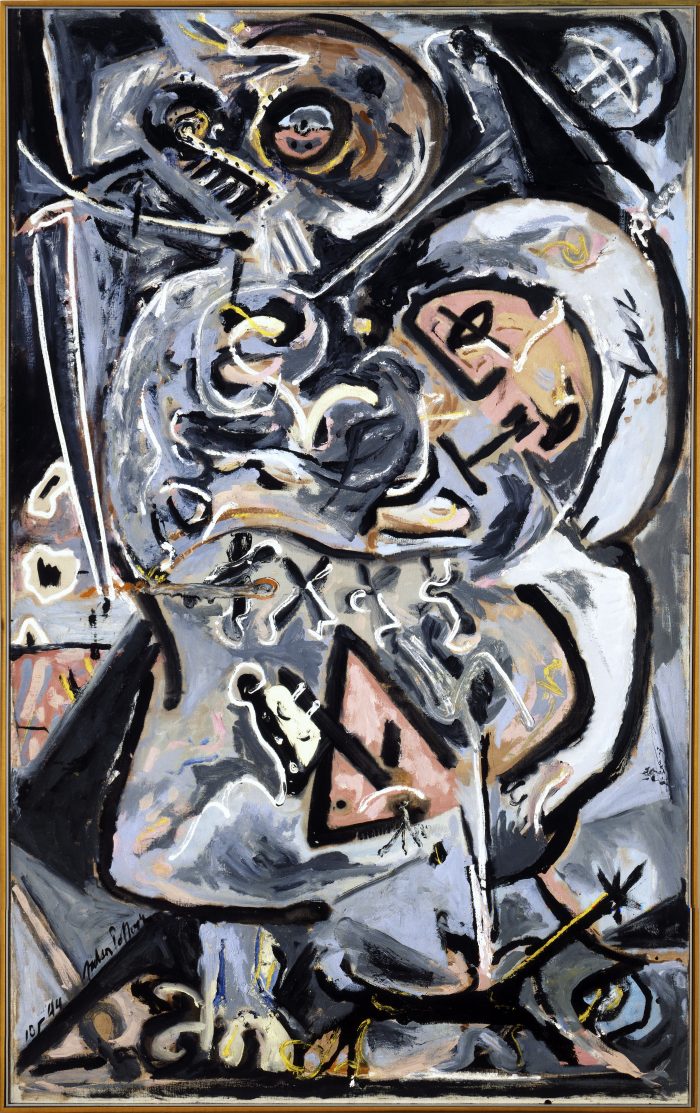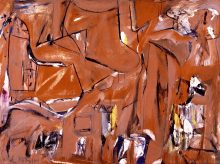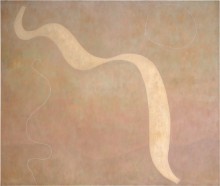Jackson Pollock
Totem Lesson I 1944

© 2019 The Pollock-Krasner Foundation / Artists Rights Society (ARS), New York. Reproduction of this image, including downloading, is prohibited.
Audio Description (02:40)
Full Audio Transcript (Expand)
Totem Lesson I
Jackson Pollock’s name might often bring to mind his large-scale drip paintings where he poured or splashed paint onto the canvas. He also created semi-figurative works that are still quite abstract. In these, he painted with a brush. The viewer can discern intentional objects and shapes throughout, and different forms might seem to arise with each encounter.
Totem Lesson I from 1944 may at first seem to be a surreal jumble of discrete images hovering above a jet-black background. Objects and sections are outlined in thick, bold black lines. Sometimes, the black lines are highlighted with thinner lines of gleaming white. Between these black lines, images float on swatches of pale blue gray. Salmon-pink faces, flashes of curvy yellow lightning, triangles, and black crosses and ankhs are some of the items scattered across the nearly-six-foot tall by three-and-a-half-foot wide canvas. Short wavy lines and curves in black or white can be found all over. They contribute to a sensation that the images might be caught in a fast-flowing river where they tilt every which way as the imagined water churns. Near the bottom right, something painted in black spans half the width of the painting. It is accented by slender gold lines: perhaps a leafless fallen tree, its long branches touching earth, and its short roots reaching skyward. Above and to the left of it, something like a black-and-white critter clamps onto the underside of a stick that pokes out of a peach-colored triangle. The stick could be the continuation of a nose or eye contained within the triangle. Toward the top of the painting might be a feather or a comb, or maybe the arm of a record player just setting its needle down onto a record.
Pollock was fascinated by the motifs of indigenous North American art. As implied by the artwork’s name, the painting may have been inspired by Native American totem poles. Totem poles are monuments made from posts. They have imagery carved into them so that they appear stacked one on top of the other. Totem poles are a dynamic blend of rich colors, curves, and angles that unite to represent nature, life, family, and spiritual symbols. The shapes may be realistic or abstractions. While this painting contains all of these elements, the nonlinear way that the images are placed on the canvas ensures this is not an imitation of work from any indigenous culture. From a quiet spot in the bottom left corner, a black line pokes up at a 45-degree angle to barge into the main assortment of shapes. Painted in thin cursive along that line in black: “10-44 Jackson Pollock.”







